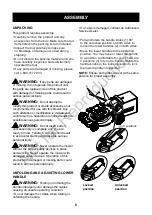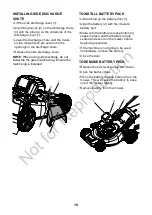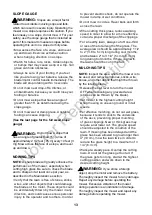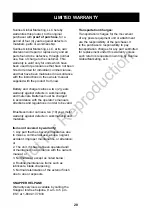
13
SLOPE GAUGE
WARNING:
Slopes are a major factor
related to accidents involving slips and falls,
which can result in severe injury. Operating the
mower on a slope requires extra caution. If you
feel uneasy on a slope, do not mow it. For your
safety, use the slope gauge that is included as
part of this manual to measure slopes before
operating this unit on a sloped or hilly area.
• Mow across the face of a slope, and never
up and down. Exercise extreme caution
when changing direction on a slope.
• Watch for holes, ruts, rocks, hidden objects,
or bumps that may cause a slip or a trip. Tall
grass can hide obstacles.
• Always be sure of your footing. If you feel
like you are losing your balance, release the
blade/motor control handle immediately. The
blade will stop rotating within 3 seconds.
• Do not mow near drop-offs, ditches, or
embankments, because you could lose your
footing or balance.
• Do not mow a slope that has an angle of
greater than 15°, as determined using the
slope gauge.
• Do not mow wet or damp grass. Unstable
footing can cause slipping.
(See the last page for the full sized slope
gauge)
WARNING:
Do not mow a slope that
has an angle of greater than 15° (a rise of
approximately 2 1/2 feet [.75 m] every 10 feet [3
m]). Mow across the face of a slope, and never
up and down.
MOWING TIPS
NOTE:
A sharp blade will greatly enhance the
performance of the mower, especially when
cutting high grass. Be sure to check the blade
and to sharpen it at least once per year, as
described in the Maintenance section.
• Verify that the lawn is free of stones, sticks,
wires, and other objects that could damage
the blades or the motor. These objects could
be accidentally thrown by the mower in any
direction, and could cause serious personal
injury to the operator and to others. In order
to prevent electric shock, do not operate the
mower in damp or wet conditions.
• Do not mow in circles. Travel back and forth
across the lawn.
• When cutting thick grass, reduce walking
speed in order to allow for a more effective
cut and a proper discharge of the clippings.
• For a healthy lawn, always cut off one-third
or less of the total length of the grass. The
average lawn should be approximately 1 1/2
to 2” (3.8 to 5 cm) long during cool months,
and between 2" to 3 1/4" (5 cm to 8.3 cm)
long during hot months. If there is growth,
the lawn should be cut in the fall.
MULCHING TIPS
NOTE:
Inspect the area where the mower is to
be used, and remove all stones, sticks, wire,
bones, and other debris that might be thrown
by the rotating blade.
• Release the bail lever to turn the mower
OFF when crossing any graveled area
(stones can be thrown by the blade).
• Set mower to the highest cutting height
when mowing on uneven ground or in tall
weeds.
• For effective mulching, do not cut wet grass,
because it tends to stick to the underside
of the deck, preventing proper mulching
of grass clippings. New or thick grass may
require a narrower cut. The ground speed
should be adjusted to the condition of the
lawn. If mowing has been delayed and the
grass has been allowed to grow longer than
4" (10 cm), mow the lawn twice in order to
reduce the grass height to a maximum of 3
1/4” (8.3 cm).
• Walk at a steady pace. Overlap the cutting
rows. Do not let the grass get too tall. If
the grass gets too long, start at the highest
cutting position and work down to the
desired cutting height.
WARNING:
If you strike a foreign
object, stop the motor and remove the battery.
Thoroughly inspect the mower for any damage.
Repair any damage before operating the
mower. Excessive vibration of the mower
during operation is an indication of damage.
Thoroughly inspect the mower and repair any
damage before operating the mower.
Not
for
Reproduction








































